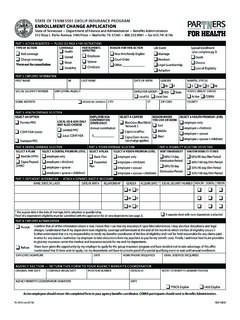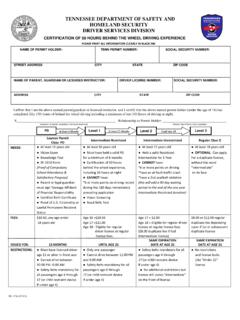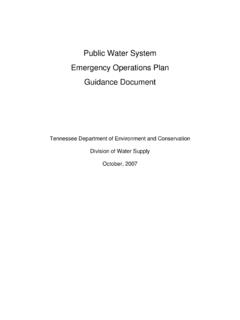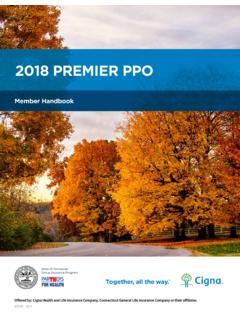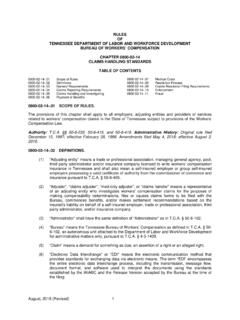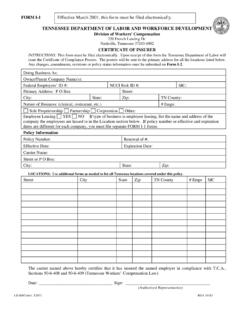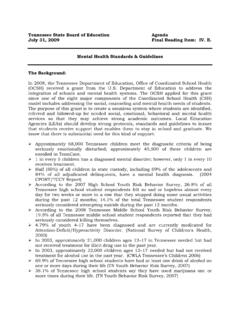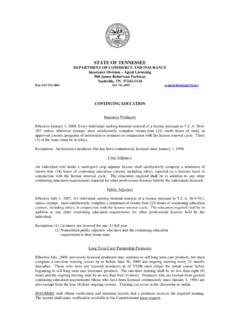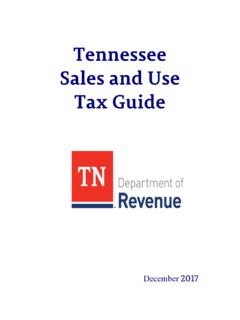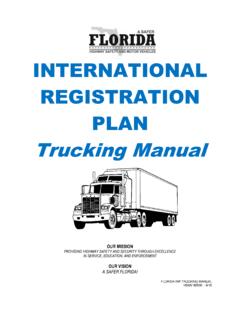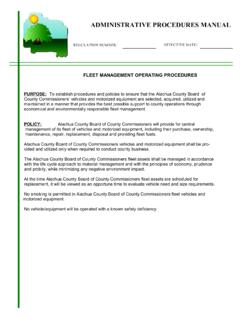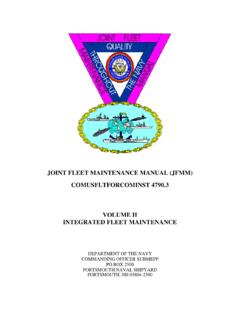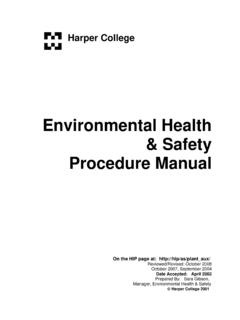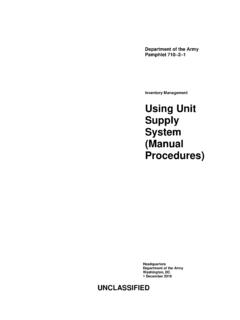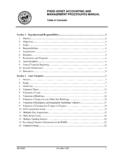Transcription of VEHICLE FLEET MAINTENANCE PLAN - Tennessee
1 VEHICLE FLEET . MAINTENANCE PLAN. FORMAL APPROVAL OF POLICY. This Plan has been approved by the Board or Governing Body. _____ _____. Authorized signature Date of Approval (AGENCY NAME). (List the Complete Address, phone number and email for Agency). VEHICLE FLEET MAINTENANCE PLAN. INTRODUCTION. (Agency Name) in its continuous development and concern for the safety of its staff and community members has developed this MAINTENANCE plan. This is a living document that will be updated on an as needed basis and reviewed annually for compliance to new rules, regulations, and laws. This plan is designed to keep all vehicles and related equipment in safe, reliable, and operational condition. It requires management , drivers, and related staff to be well trained and accountable for specific roles. Specific roles management . (Agency Title of Staff) will make sure that all staff is properly trained and certified as deemed appropriate to perform preventive MAINTENANCE on the vehicles and will document all MAINTENANCE related activities.
2 DRIVERS. The drivers must be certified according to State laws. Driver must know the proper starting, shifting, and braking procedures to extend the life of the VEHICLE and must be vigilant in reporting his/her observations. No VEHICLE should be sent into service low on oil, antifreeze, automatic transmission, or power steering fluid. Unsealed batteries and windshield washer fluid must also be checked and filled. Drivers should be alert for unusual noises, bad tires, noisy or poor brakes, and clutch adjustments. All drivers should be completely familiarized with the vehicles including engine compartment, driver controls, and passenger safety devices. Drivers should be trained to recognize unusual noises and describe basic mechanical problems to the supervisor and/or mechanic. Page 2 of 27. VEHICLE FLEET MAINTENANCE . GOALS AND OBJECTIVES. (Agency Name) will use the MAINTENANCE plan to obtain the goals listed below: 1).
3 2). Our objectives to complete the goals listed above include: 1). 2). 3). 4). (Agency Name) has the means to carry out the goals and objectives by: 1). 2). GENERAL AGENCY AND VEHICLE FLEET INFORMATION. (Describe the type of vehicles in the FLEET , the basic kind of transportation provided by the Agency, basic area that is covered, specific location(s) where the VEHICLE (s) is parked, and state how many vehicles is ADA complimentary.). Page 3 of 27. PREVENTIVE MAINTENANCE INSPECTIONS & SERVICES. INTRODUCTION. VEHICLE and component ( , handicapped access equipment) manufacturers manuals are an important part of the VEHICLE MAINTENANCE plan as they define specific MAINTENANCE intervals and provide critical information when the MAINTENANCE work is actually to be performed. Preventive MAINTENANCE (PM) inspections and Scheduled services should follow the recommended intervals by the manufacturer.
4 If preventive MAINTENANCE services are not being done according to the guidelines of the manufacturer, the agency may jeopardize any claim to a warranty. (See Appendix F: Preventative & Scheduled MAINTENANCE Chart). Services eligible for warranty payment must be made by the appropriate personnel and filed with the manufacturer. Documentation of such services should remain in the VEHICLE file. (Agency Name) operates a warranty recovery program to ensure that cost of parts and repairs on warranty-covered items are recovered. Return to manufacturer/vendor Authorization for warranty return and labor claims, if applicable, are obtained from the manufacturer or vendor. Information is supplied to the vendor on the circumstances of the failure, if known. The item is then returned to the vendor warranty department for repair or replacement. (Agency Name) retains copy of the warranty claim form for tracking purposes.
5 The Agency will also notify TDOT of all warranty returns. DOCUMENTATION. Preventive MAINTENANCE (PM) inspections and Scheduled services should be performed, and documented according to a proper schedule. All documentation including MAINTENANCE forms, logs, receipts, inspections, and trip logs should be kept through the life of the VEHICLE plus 3 years. Whenever a mechanic or tow truck is dispatched to a VEHICLE in service, documentation should be submitted and placed in the VEHICLE file. (Agency Title of Staff) is responsible for maintaining the VEHICLE documentation. (See Appendix A: Information for Onsite Mechanic/Tow Sheet). PM INSPECTIONS. Preventive MAINTENANCE (PM) inspections are basic inspections to help provide an opportunity to detect and repair damage or wear conditions before major components need repairs. These inspections generally cover: A list of specific items to be checked Page 4 of 27.
6 Record repairs and the routine application of fluids Indicate inspection interval ( , daily or weekly); and mileage Indicate if repair/replacement needed for an item. (See Appendix B: Daily Inspection Checklist). IDENTIFIED DEFECTS. Identified defects should be reported to (Agency Title of Staff). Defects must be reviewed and repaired based on the categories listed: SAFETY DEFECT. The VEHICLE cannot be released until the repairs are completed, except in case of an emergency. Safety cannot be compromised. MECHANICAL DEFECT. A defect that will worsen and increase cost. The VEHICLE cannot be released until the repairs are completed, except in case of an emergency. ELECTIVE MECHANICAL DEFECT. A defect that does not compromise safety will not cause further damage if operated but needs to be corrected prior to the next PM cycle. Repair should be scheduled. Due to transportation costs and disruption to operations, this decision should not be made lightly.
7 ELECTIVE OR COSMETIC DEFECT. The defect will not compromise safety and will not cause further damage or cost as it is an aesthetic defect. The VEHICLE should be scheduled for an off-peak time in the future, as determined by management , or at the next scheduled PM. Service. (See Appendix C: Reporting Defects sheet). TYPES AND DESCRIBTIONS OF PM INSPECTIONS. The manufacturer's recommended service schedule should be adhered to by either mileage or months. Basic PM Services are 4 levels that are listed below: (Note: See Manufacturer's Manual for mileage/month internals). Level A Conducted at (? Miles/ ? months interval). Change oil and filter, inspect tires, electrical system, service all fluid levels, lubricate chassis and doors, check A/C, hoses, fire extinguishers, belts, brakes, lights, test drive, body damage, etc. Inspect and test VEHICLE lift. Level B Conducted at (? Miles/ ? months interval).
8 Includes all items in level A. Check coolant, specific gravity, and ph. Page 5 of 27. Level C Conducted at (? Miles/ ? months interval). All items in levels A and B, plus change fuel filter, replace air filter, and inspection of braking system. Level D Conducted at (? Miles/ ? months interval). All items in levels A, B, and C, plus inspection and repack of wheel bearings. (See Appendix D: PM Service Schedule sheet). PRE/POST TRIP INSPECTIONS. An important aspect of preventive MAINTENANCE is the establishment of strong communication between drivers and management . An easy way to ensure and document this communication link is through the use of the driver's daily VEHICLE inspection checklist that is either a pre-trip or post-trip inspection. The driver should identify any defects and report them to (Agency Title of Staff). All checklists are to be maintained in the VEHICLE 's permanent file.
9 The pre- and post-trip inspection forms shall be legibly completed and signed by the VEHICLE driver. A pre-trip inspection should include as a minimum: (See Appendix G: Pre-Trip Inspection Report and Appendix H: Post Trip Inspection Report). Cleanliness Properly maintained and free of loose articles. Lights and reflectors High/low beams, tail lights, turn signals, 4-way hazard flashers, marker lights, license plate light and reflectors should be cleaned as needed Brakes Both foot and emergency brakes should be capable of effectively stopping or restraining the VEHICLE . Brake pedal should be firm after 1-2 inch free- play on a single down stroke. No noises, vibration or steering changes should result from applying the brakes while moving. Horn Gives an adequate and reliable warning signal. Windshield, washer, wipers and defroster Surfaces must be clean and unobstructed, inside and outside.
10 Washer reservoirs are to be filled as needed. Mirrors All rear vision mirrors must be clean, properly adjusted and unobstructed. Outside mirrors must be mounted on both sides. Tires Must be of adequate load capacity when VEHICLE is fully loaded. Tires shall be inflated to recommended pressures and compatible with each set ( , all radials or all bias ply; no mixed sets.) Tire wear surfaces and sidewalls shall be inspected daily for debris, damage, and wear. Tires shall be replaced prior to revealing the wear bars between the treads at the contact surface. Speedometer Shall be operational and accurately record speed. Page 6 of 27. Seat Belts If the VEHICLE has seat belts, they must be in good operating condition and used by all passengers and drivers. Wheelchair passenger restraints and securement systems shall be fully operational. Doors Capable of being opened, shut, and locked as required.
